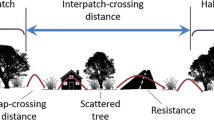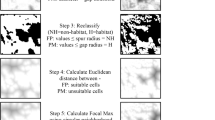Abstract
In urbanising landscapes, planning for sustainable biodiversity occurs in a context of multifunctional land use. Important conditions for species persistence are habitat quality, the amount and configuration of habitat and the permeability of the landscape matrix. For planning purposes, these determinants should be integrated into simple indicators for spatial conditions of persistence probability. We propose a framework of three related indices. The cohesion index is based on the ecology of metapopulations in a habitat network. We discuss how an indicator for species persistence in such a network could be developed. To translate this network index into an area index, we propose the concept of spatial cohesion. Habitat cohesion and spatial cohesion are defined and measured for single species or, at best, for species profiles. Since species differ in their perception of the same landscape, different species will rate different values of these indices for the same landscape. Because landscapes are rarely planned for single species, we further propose the index of landscape cohesion, which integrates the spatial cohesion indices of different species. Indices based on these concepts can be built into GIS tools for landscape assessment. We illustrate different applications of these indices, and emphasise the distinction between ecological and political decisions in developing and applying such tools.
Similar content being viewed by others
REFERENCES
Adler F.R. and Nuernberger B. 1994. Persistence in patchy irregular landscapes. Theoretical Population Biology 45: 41–75.
Ahern J. 1999. Integration of landscape ecology and landscape design: an evolutionary process. In:Wiens J.A. and Moss M.R. (eds), Issues in Landscape Ecology. International Association of Landscape Ecology, Guelph, Ontario, Canada, pp. 119–123.
Andrén H. 1994. Effects of habitat fragmentation on birds and mammals in landscapes with different proportions of suitable habitat: a review. Oikos 71: 355–366.
Andrén H. 1996. Population responses to habitat fragmentation: statistical power and the random sample hypothesis. Oikos 76: 235–242.
Anonymus 1997. Natuurverkenning 97. Samson H.D. Tjeenk Willink, Alphen aan den Rijn, The Netherlands.
Doak D.F. 1989. Spotted owls and old growth logging in the pa-cific north-west. Conservation Biology 3: 389–396.
Dunning J.B. Jr, Borgella R., Clements C. and Meffe G.K. 1995. Patch isolation, corridor effects, and colonization by a resident sparrow in a managed pine woodland. Conservation Biology 9: 542–550.
Ettienne R.S. and Heesterbeek J.A.P. 2001. Rules of thumb for conservation of metapopulations based on a stochastic winking-patch model. American Naturalist 158: 389–407.
Fahrig L. and Merriam G. 1994. Conservation of fragmented populations. Conservation Biology 8: 50–59.
Fahrig L. 1999. When is a landscape perspective important? In:Wiens J.A. and Moss M.R. (eds), Issues in Landscape Ecology. International Association of Landscape Ecology, Guelph, Ontario, Canada, pp. 145–147.
Fahrig L. 2001. How much habitat is enough? Biological Conservation 100: 65–74.
Foppen R.P.B., Chardon J. and Liefveld W. 2000. Understanding the role of sink patches in source-sink metapopulations: reed warblers in an agricultural landscape. Conservation Biology 14: 1881–1892.
Foppen R. 2001. Bridging gaps in fragmented marshland. Applying landscape ecology for bird conservation. PhD Dissertation, Wageningen University/Alterra Scientific Contributions 4, Wageningen, The Netherlands.
Frank K. and Wissel C. 1998. Spatial aspects of metapopualtion survival-from model results to ruels of thumb for landscape management. Landscape ecology 13: 363–379.
Frank K. and Wissel C. 2002. A formula for the mean lifetime of metapopualtions in heterogeneous landscapes. American Naturalist 159: 530–552.
Geertsema W., Opdam P.F.M. and Kropff M.J. 2002. Plant strategies and agricultural landscapes: survival in spatially and temporally fragmented habitat. Landscape Ecology 17: 263–279.
Gustafson E. 1998. Quantifying landscape spatial pattern: what is the state of the art? Ecosystems 1: 143–156.
Hanski I. 1994. A practical model of metapopulation dynamics. Journal of Animal Ecology 63: 151–162.
Hanski I. 1997. Metapopulation dynamics, from concepts and observations to predictive models. In:Hanski I.A. and Gilpin M.E. (eds), Metapopulation Biology. Academic Press, London, UK, pp. 69–91.
Hanski I. 1999. Habitat connectivity, habitat continuity, and meta-populations in dynamic landscapes. Oikos 87: 209–219.
Harms B., Knaapen J.P. and Rademakers J.G. 1993. Landscape planning for nature restoration: comparing regional scenarios. In:Vos C.C. and Opdam P. (eds), Landscape Ecology of a Stressed Environment. Chapman & Hall, London, UK, pp. 197–218.
Hanski I. and Simberloff D. 1997. The metapopulation approach, its history, conceptual domain, and application to conservation. In:Hanski I.A. and Gilpin M.E. (eds), Metapopulation Biology. Academic Press, London, UK, pp. 5–26.
Henderson M.T. and Merriam G. 1985. Patchy environments and species survival: chipmunks in an agricultural mosaic. Biological Conservation 31: 95–105.
Harrison S., Murphy D.D. and Ehrlich P.R. 1988. Distribution of the bay checkerspot butterfly, Euphydryas editha bayensis: evidence for a metapopulation model. American Naturalist 132: 360–382.
Hoogeveen Y.R. 2001. Analyse ruimtelijke samenhang natuurge-bieden: scenariostudie ex-ante toets VIJNO. intern report Al-terra. Alterra, Wageningen, The Netherlands.
Lande R. 1987. Extinction thresholds in demographic models of territorial populations. American Naturalist 130: 624–635.
Lindenmayer D.B. and Lacy R.C. 1995. A simulation study of the impacts of population subdivision on the mountain brushtail possum Trichosurus caninus Ogilby (Phalangeridae: marsupi-alia) in south-eastern Australia. I. Demographic stability and population persistence. Biological Conservation 73: 119–129.
Lindenmayer D.B. and Possingham H.P. 1995. Modelling the viability of metapopulations of the endangered Leadbeaters's pos-sum in South-eastern Australia. Biodiversity and Conservation 4: 984–1018.
Lomolino M.V. 1994. An evaluation of alternative strategies for building networks of nature reserves. Biological Conservation 69: 243–249.
Margules C.R., Nicholls A.O. and Pressey R.L. 1988. Selecting networks of reserves to maximise biological diversity. Biological Conservation 43: 63–76.
Margules C. 1999. Conservation planning at the landscape scale. In:Wiens J.A. and Moss M.R. (eds), Issues in Landscape Ecology. International Association of Landscape Ecology, Guelph, Ontario, Canada, pp. 83–87.
Matthysen E. and Currie D. 1996. Habitat fragmentation reduces disperser success in juvenile nuthatches Sitta europaea: evi-dence from patterns of territory establishment. Ecography 19: 72–76.
Merriam G. 1988. Landscape dynamics in farmland. Trends in Ecology and Evolution 3: 16–20.
Mönkkönen M. and Reunanen P. 1999. On critical thresholds in landscape connectivity: a management perspective. Oikos 84: 302–305.
Moss M.R. 1999. Fostering Academic and Institutional Activities in Landscape Ecology. In:Wiens J.A. and Moss M.R. (eds), Issues in Landscape Ecology. International Association for Landscape Ecology, Guelph, Ontario, Canada, pp. 138–144.
Nassauer J.I. 1999. Culture as a means for experimentation and action. In:Wiens J.A. and Moss M.R. (eds), Issues in Landscape Ecology. International Association of Landscape Ecology, Guelph, Ontario, Canada, pp. 129–133.
Opdam P. 1988. Populations in fragmented landscape. In:Schreiber K.F. (ed.), Connectivity in Landscape Ecology. Münstersche Geographische Arbeiten 29, Münster, Germany, pp. 75–77.
Opdam P. 1991. Metapopulation theory and habitat fragmentation: a review of holarctic breeding bird studies. Landscape Ecology 5: 93–106.
Opdam P., Van Apeldoorn R., Schotman A. and Kalkhoven J. 1993. Population responses to landscape fragmentation. In:Vos C.C. and Opdam P. (eds), Landscape Ecology of a Stressed Environ-ment. Chapman and Hall, London, UK, pp. 147–171.
Opdam P., Foppen R., Reijnen R. and Schotman A. 1995. The landscape ecological approach in bird conservation: integrating the metapopulation concept into spatial planning. Ibis 137: 139–146.
Opdam P. 2002. Assessing the conservation potential of habitat networks. In:Gutzwiller K.J. (ed.), Applying Landscape Ecology in Biological Conservation. Springer Verlag, New York, New York, USA, pp. 381–404.
Opdam P. and Wiens J.A. 2002. Fragmentation, habitat loss and landscape management. In:Norris K. and Pain D. (eds), Con-serving Bird Biodiversity. Cambridge University Press, UK, pp. 202–223.
Opdam P., Foppen R. and Vos C.C. 2002. Bridging the gap between empirical knowledge and spatial planning in landscape ecology. Landscape Ecology 16: 767–779.
Possingham H.P., Lindenmayer D.B., Norton T.W. and Davies I. 1994. Metapopulation viability analysis of the greater glider Petauroides volans in a wood production area. Biological Conservation 70: 227–236.
Pouwels R., Jochem R., Reijnen M.J.S.M., Hensen S.R. and Van der Greft J.G.M. 2002. LARCH voor ruimtelijk ecologische beoordelingen van landschappen. Report Alterra 492. Alterra, Wageningen, The Netherlands.
Pressey R. and Nicholls A.O. 1989. Application of a numerical algorithm to the selection of reserves in semi-arid New South Wales. Biological Conservation 50: 263–278.
Reijnen R. and Koolstra B. 1998. Evaluation of corridor effectiveness in the Gelderland Province (in Dutch). Research report 372. Institute for Forestry and Nature Research, Wageningen, The Netherlands.
Reijnen R., Van der Grift E., Van der Veen M., Pelk M., Lüchten-borg A. and Bal D. 2000. De weg mét de minste weerstand. Opgave ontsnippering. Alterra and Expertisecentrum LNV, Wageningen, The Netherlands.
Schumaker N. 1996. Using landscape indices to predict habitat connectivity. Ecology 77: 1210–1225.
Sjögren P. 1991. Extinction and Isolation gradients in metapopulations-the case of the pool frog, Rana lessonae. Biological Journal of the Linnean Society 42: 135–147.
Smith A.T. and Gilpin M. 1997. Spatially correlated dynamics in a Pika population. In:Hanski I.A. and Gilpin M.E. (eds), Meta-population Biology. Academic Press, London, UK, pp. 407–428.
Sutcliffe O. and Thomas C.D. 1996. Open corridors appear to facilitate dispersal of Ringlet Butterflies (Aphantopus hyperan-thus) between woodland clearings. Conservation Biology 10: 1359–1365.
Ter Braak C.J.F., Hanski I. and Verboom J. 1998. The incidence function approach in modelling of metapopulation dynamics. In:Bascompte J. and Solé R.V. (eds), Modeling Spatio-Tempo-ral Dynamics in Ecology. Springer Verlag and Landes Bioscience, New York, New York, USA, pp. 167–188.
Theobald D.M., Hobbs N.T., Bearly T., Zack J.A., Shenk T. and Riebsame W.E. 2000. Incorporating biological information in local land-use decision making: designing a system for conser-vation planning. Landscape Ecology 15: 35–45.
Thomas C.D. and Hanski I. 1997. Butterfly metapopulations. In:Hanski I.A. and Gilpin M.E. (eds), Metapopulation Biology. Academic Press, London, UK, pp. 359–386.
Thomas C.D. and Kunin W.E. 1999. The spatial structure of populations. Journal of Animal Ecology 68: 647–657.
Tilman D. and Kareiva P. (eds) 1997. Spatial Ecology: The Role of Space in Population Dynamics and Interspecific Interactions. Princeton University Press, Princeton, New Jersey, USA.
Van Dorp D. and Opdam P.F.M. 1987. Effects of patch size, isola-tion and regional abundance on forest bird communities. Land-scape Ecology 1: 59–73.
Verboom J., Schotman A., Opdam P. and Metz J.A.J. 1991. European nuthatch metapopulations in a fragmented agricultural landscape. Oikos 61: 149–156.
Verboom J., Opdam P. and Schotman A. 1991c. Kerngebieden en kleinschalig landschap: een benadering met een metapopulati-emodel. Landschap 8: 3–13.
Verboom J., Metz J.A.J. and Meelis E. 1993. Metapopulation models for impact assessment of fragmentation. In:Vos C.C. and Opdam P. (eds), Landscape Ecology of a Stressed Landscape. Chapman and Hall, London, UK, pp. 172–191.
Verboom J., Foppen R., Chardon P., Opdam P. and Luttikhuizen P. 2001. Standards for persistent habitat networks for vertebrate populations: the key patch approach. An example for marsh-land bird populations. Biological Conservation 100: 89–102.
Villard M., Merriam G. and Maurer B.A. 1995. Dynamics in sub-divided populations of neotropical migratory birds in a frag-mented temperate forest. Ecology 76: 27–40.
Villard M., Trzcinski M.K. and Merriam G. 1999. Fragmentation effects on forest birds: Relative influence of woodland cover nd configuration on landscape occupancy. Conservation Biology 13: 774–783.
Vos C.C. and Chardon J.P. 1998. Effects of habitat fragmentation and road density on the distribution pattern of the moor frog Rana arvalis. Journal of Applied Ecology 35: 44–56.
Vos C.C., Ter Braak C.J.F. and Nieuwenhuizen W. 2000. Empirical evidence of metapopulation dynamics; the case of the Tree frog (Hyla arborea). Ecological Bulletins 48: 165–180.
Vos C.C., Verboom J., Opdam P.F.M. and Ter Braak C.J.F. 2001. Towards ecologically scaled landscape indices. American Naturalist 157: 24–51.
Vos C.C., Baveco H. and Grashof-Bokdam C.J. 2002. Corridors and species dispersal. In:Gutzwiller K.J. (ed.), Applying Landscape Ecology in Biological Conservation. Springer Verlag, New York, New York, USA, pp. 84–104.
Wahlberg N., Moilanen A. and Hanski I. 1996. Predicting the occurrence of endangered species in fragmented landscapes. Science 273: 1536–1538.
Wiens J.A. 1997. Metapopulation dynamics and landscape ecology. In:Hanski I.A. and Gilpin M.E. (eds), Metapopulation Biology. Academic Press, London, UK, pp. 43–62.
With K.A., Gardner R.H. and Turner M.G. 1996. Landscape connectivity and population distributions in heterogeneous environments. Oikos 78: 151–169.
With K.A. and King A.W. 1999. Extinction thresholds for species in fractal landscapes. Conservation Biology 13: 14–326.
Author information
Authors and Affiliations
Rights and permissions
About this article
Cite this article
Opdam, P., Verboom, J. & Pouwels, R. Landscape cohesion: an index for the conservation potential of landscapes for biodiversity. Landscape Ecology 18, 113–126 (2003). https://doi.org/10.1023/A:1024429715253
Issue Date:
DOI: https://doi.org/10.1023/A:1024429715253




